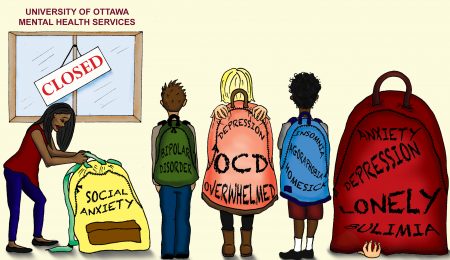Every year during Bell Let’s Talk Day, social media outlets become awash with posts and hashtags designed to create a culture of acceptance around mental health issues. While this is a laudable goal, it’s important to be critical of the corporate-driven image of mental illness, how accurate it is in depicting real-life struggles of people with mental illness, as well as the overall effect on the community the campaign is targeted towards.
Don’t get us wrong, money is important and even necessary for advances in mental health care. Discussion on one day of the year is better than no discussion at all, and could, in theory, lead to more mainstream acceptance of discussing the issue outside of that single day.
The campaign in and of itself is not a waste of time. However, it’s important to recognize that the current campaign serves to alienate members of the very community it proclaims to help. It’s important to recognize that Bell Let’s Talk Day is not enough to beat the stigma around mental illness.
First of all, upon seeing the advertisements and promotional material for the campaign, it becomes clear that certain disorders hog the spotlight. For example, Bell Let’s Talk videos are chock full of testimonials from those who suffer with depression, anxiety, post-traumatic stress disorder, and obsessive compulsive disorder.
However, it’s worth noting that in its years of campaigning, there is absolutely no mention of addiction, dissociative identity disorder, schizophrenia, bipolar disorder, or any other mental illness that “doesn’t fit” the shiny, hopeful promotional videos.
While it’s not possible to include every disorder in a mental health campaign, the representation of illness in Bell Let’s Talk videos shows clear favouritism towards illnesses that have been accepted in mainstream media for a longer time. For example, if someone discloses to you that they hear voices, experience hallucinations, or can’t stop taking heroin, would you have the same reaction as if someone told you they were dealing with extreme, prolonged sadness?
One of these disclosures all too often invites the labels of “crazy” and “dangerous.” And if we, as a society, collectively agree that we need to address the stigma around mental illness, discrimination in the way we perceive different illnesses cannot remain as the norm.
And there’s no wonder why Bell has decided these “scarier” experiences aren’t to be showcased. They have a brand to protect, and if society perceives schizophrenics as more likely to be violent, even though there’s no evidence to back up this claim, Bell can’t afford to put their brand reputation on the line by associating themselves with “violent” members of society.
Could you imagine Bell’s board of directors approving a campaign that shows someone detailing their experience clawing through their own skin due to hallucinations? How would that look against their shiny white backdrop, and the fluttery, hopeful piano music?
But self-harm and hallucinations are a reality for some people living with schizophrenia. So because a corporate board is unhappy with the optics, should we really delegitimize this experience in such a society-wide manner? Because this is exactly what we do when we treat Bell Let’s Talk as the leading campaign for mental illness, rather than recognizing it is only a leading campaign for some mental illnesses.
In addition to the poor representation of mental illnesses, the campaign completely overlooks the intersections of race, sexual orientation and gender identity, social class, among other factors, in how these illnesses manifest themselves and are treated.
For example, members of the LGBTQ+ community are almost three times as likely as cisgender, heterosexual people to experience a mental illness. The numbers are even higher for queer and trans youth, specifically for suicide rates and substance abuse. In Indigenous communities across Canada, the suicide rate is 6 to 11 times higher than the rest of the country. According to the U.S. Department of Health and Human Services, African-Americans are 20 per cent more likely to report experiencing severe psychological distress than whites.
Clearly, when it comes to mental illness, intersectionality matters. However, the majority of the Bell Let’s Talk representatives in promotional materials did not identify as part of a marginalized group or discuss mental health in relation to their experience within a marginalized group. And when that happens, we perpetuate the idea that all of us suffer from mental illness in the same way, when this is statistically not true.
The campaign also ignores disparities in mental health treatment for minority groups, and that ethnic minorities are less likely to receive care. People from marginalized communities require care that is both culturally sensitive and that addresses their unique needs on the basis of their identity, yet Bell Let’s Talk fails to address this. Ultimately, this leads us to miss out on an entire dimension of mental illness that should be central in our perceptions of it.
Finally, mental illness is often tied to political factors. For example, when requests by the Indigenous communities of our nation are ignored by the Canadian government. But Bell would not run promotional materials featuring suicidal young women living on reserves, no matter how timely the issue is, because why would they want to make an enemy out of our government? They have little to gain from that move, and a lot to lose, no matter how valuable it would be to see the effects of political decisions on the mental health of certain communities.
When the narrative of mental illness is controlled by a corporation, the public relations element becomes a huge factor in how mental illness is conveyed. Instead of representing the diverse realities of mental illness, Bell Let’s Talk caters itself to the “average” Canadian—white, cisgender, able-bodied, heterosexual, and middle-class. But since when should corporations dictate what society views as “normal” in the realm of mental health? Especially when this corporation fired an employee, allegedly on the grounds of needing time off for her mental health? It’s time to take back our narrative of mental illness, and stop accepting easy-to-swallow depictions of mental illness as the society-wide norm.
Mental health care is better and more effective when more voices are involved. But those voices need to be legitimized and given a public platform before we can make any real strides in mental health care. We can’t stop at Bell Let’s Talk Day—because we can do a hell of a lot better.





